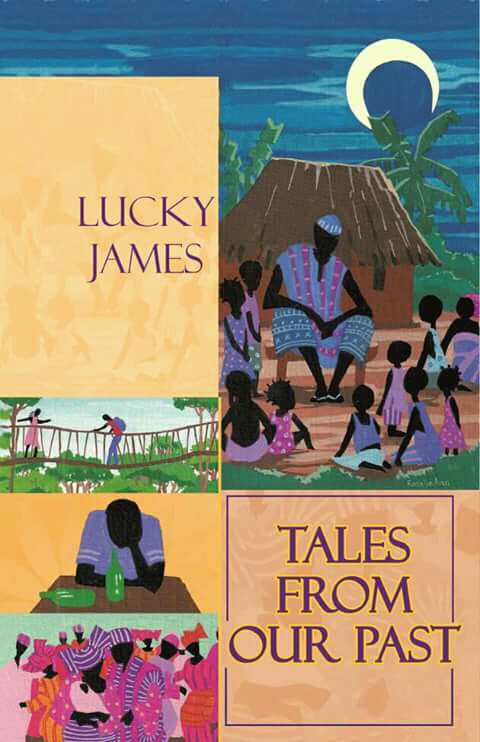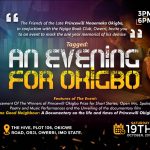
Tales from our Past is a collection of fifteen momentous short stories that readily serve as windows through which we see the many facets of our existence. The stories are told with great artistic verve, sparking off and burning deep in the characters which gives them right to contest there animation. The characters’ experiences are reflective shadows of our very selves, our day to day lives, quests, conquests, failures and triumphs, portraying as it were; the frailties of human kind and the attendant idiosyncrasies. The narrative techniques swing –like a pendulum chartering its own course –from the first person point of view to the third, and a quick double back to the omniscient. Through this multiplicity of narrative styles, we are escorted into the recess of the remotest part of the society, where humanity is laid bare for our uncensored comprehension.
The very first story, “The Terrifying Canopy Walk”, is one story any phobic person can easily relate with, especially an acrophobic. The setting is in Kakum Canopy Walkway in Ghana, where Georgie, the narrator went through a pitiable but funny bout of phobia that nearly led to a cardiac arrest. George together with his companions; Adwoa and Kosi a Ghanaian and Togolese respectively, was visiting from Nigeria, in view of his application for the University of Cape Coast. They had gone to the National Park to have some fun, and then the idea of a Canopy Walk came. They paid for their tickets and had barely began the ascent when Georgie discovered that “the rope bridge was not as fixed in place as it appeared” (12), making his “crippling phobia for heights to set in” and knotting his stomach (13).
Following closely is “The Eclipse”, set in an imaginary Wussa, a rural community not too far from the Niger River. Ado is the compass through whom we traverse this rural village, their sensibilities, their beliefs and naivety. A lunar eclipse was about to take place, and Ado’s school teacher, Mr. Johnson Adeko, who taught every subject and every class, brought it to their attention and informed them that it was only a natural occurrence; a time in space when the sun and the moon clashed momentarily. But the people of Wussa are not to be taken in by such scientific hogwash, for as long as Ofege, the village sage, King Shefule of Wussa, Batiga the seer and indeed all other villagers, except Mr. Thomas, the village drunk, are concerned, “the sins of the world had grown so gross that the spirits were so disgusted with humanity. The encounter at midnight was a purging process meant to correct a people that had gone astray.” (23). Daybreaks and we see a jubilant Wussa coming to the palace to congratulate King Shefule and Batiga the seer for timely intervention. The moon and the sun had disengaged as soon as they had colluded, but the Wussas believe that their intercession and that of their ancestors saved the situation.
Jumping to the ninth story, which is also the title of the collection, “Tales from Our Past”, reads a bit in structure like “The Terrifying Canopy Walk”. In this case, Kanje, the protagonist dreads snakes to a fault. The story opens where Kanje encountered a snake in their compound and “sped away… in a manner better imagined than described.” (90). Due to his excessive fear of snakes, Kanje have had to shamelessly forget what his mother asked him to buy from the market, he came home to lie that the prices went up and he couldn’t afford to buy it. On a closer reading, we discover that a snake charmer was performing his magic in the market that day, hence Kanje fled in terror. He loathed himself the day he learnt from his mischievous friends that the snake charmer never really used a real snaked, it was only a rubber look-alike. He recalls the day he abandoned his baby brother in his cot and ran for dear life because a snake entered the room:
Once this blasted reptile cleared the doorway, I shot across the room and out the door, terrified and covered with goose bumps. I must have flown out of the room because I actually did not feel the ground beneath my feet. How could my feet possibly tread the same floor on which a snake had just crawled? (93).
Out of secondary school, during one of his reunion with his schoolmates, they begin to tell the tales of their pasts and the story of his fear for snake comes up. Suddenly, from a distance, shouts of snake rent the air. He goes to the scene out of courtesy, but a reflex action soon makes him pick a stone and hurl in the snake’s direction. ‘congratulations’ went everyone, Kanje has killed a snake.
However the story “The Right to Remain Silent” ushers a bit of calm, a pause, a solemnity, a moment of serious reflection and quiet as it name rightly posits. It forms a sort of road block to the reader, having cruised through the previous stories with smiles, with a slight shake of the head or a smile not fully realized. But this story necessarily puts a road block as if the writer intentionally decided to halt us, the readers in our light hearted heels, to remind us of the essence of craft and to some extent, the essence of fiction. It is a typical Nigerian/African story where human life seems to be the least important item. I’m sure any reader will be, having witnessed the brutal, insensitive and reckless actions of the men of the Nigerian armed forces, especially the police will relate to the experience of Daniel, which is utterly heartbreaking. One can only cry so little in order not to cry so much for a nation that abuses the right of her citizens and expect medals for it, and most times gets it because justice is never served to the abused. Though Daniel shares in the blame, for being too dumb and appearing so helpless, a trait the Nigerian police looks out for in their victims to wickedly carry out their evil acts. “The Right to Remain Silent”, in my view, remains the most painful story in this collection, with its attendant theme of huge loss of time and human resources. Perhaps, we have remained silent for too long.
In all, Tales from Our Past scores a bull’s eye in chronicling the human syndrome. It is a collection of story of our very selves; our sensibilities, actions, idiosyncrasies, victories, lessons and losses. Though no writer, in his/her first attempt, writes a completely flawless story, hence there is a handful of visible flaws in structure and narrative techniques, but they are not such that can clog the flow of unfolding plots in the stories. It is also true that most writers see the short story as a rehearsal ground from which a full novel could be erected, hence, some of the stories read like a developing novel given the very fact that some did not really follow that momentary structuring of plots that short stories are known for. But then, there are much visible artistic strengths the author could be associated with; his handling of satire and humour is too masterly to be amateurish, the good use of metaphors, similes, personifications, innuendos and metonymy are quite remarkable. There is also the author’s attempt to incorporate the modernists’ technique of stream of consciousness in stories like “Bond of the Rakhi”,“Teacher Danlas”,“Sunset Years”, etc. With all these, Lucky James compiles and dishes out well flavored servings fresh from his aromatic kitchen.
About the author
 Brief Bio of Reviewer:
Brief Bio of Reviewer:
Ifesinachi Johnpaul Nwadike, poet, playwright, novelist and rapper is currently completing his Masters Degree program in African/Black Diaspora Literature at the prestigious University of Ibadan. He lives everywhere.




Dear JP,
I’m overwhelmed by your show of support for Tales from Our Past and the intellectual investment you have put into producing the review of the book. Thanks a bunch!